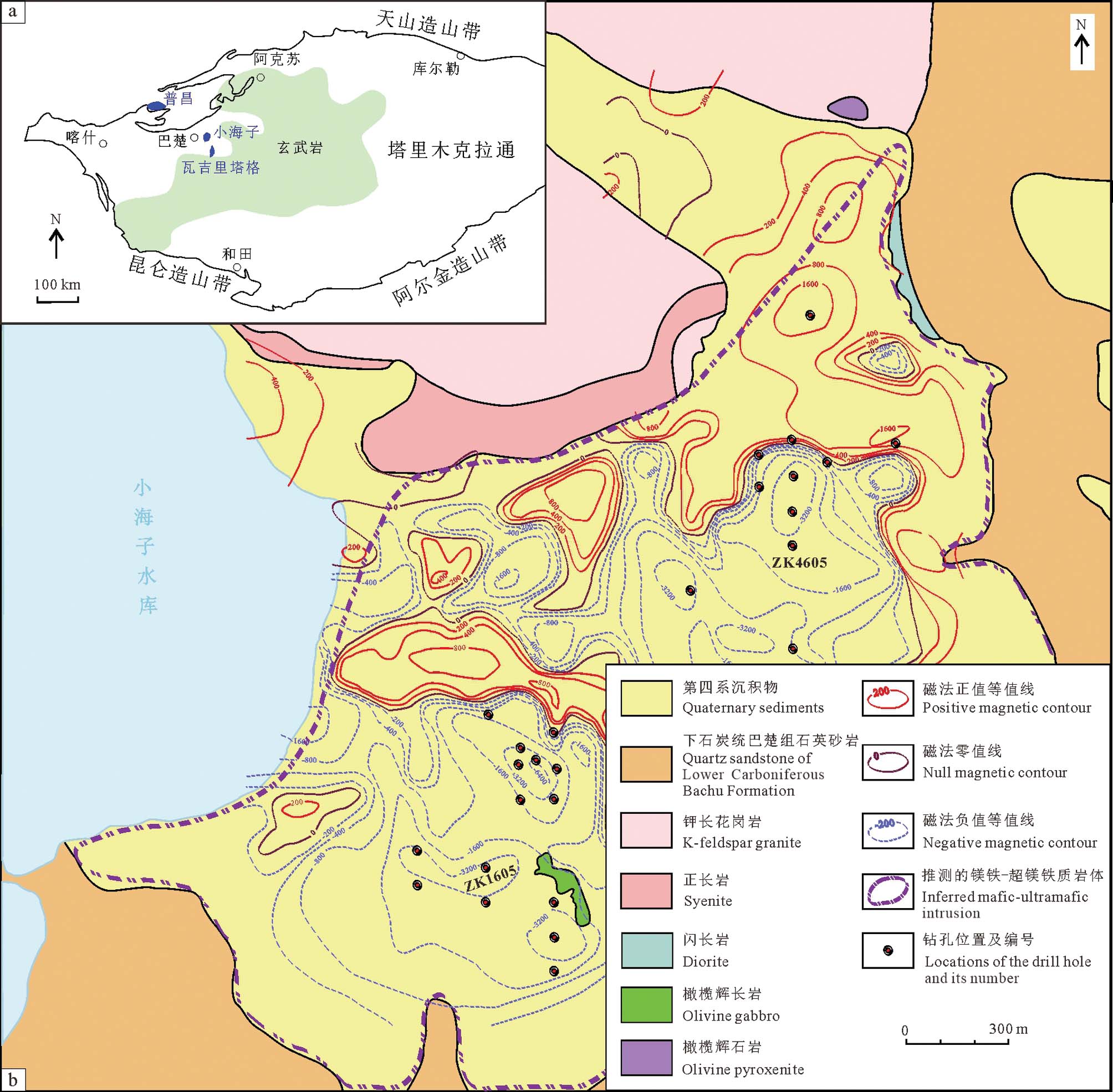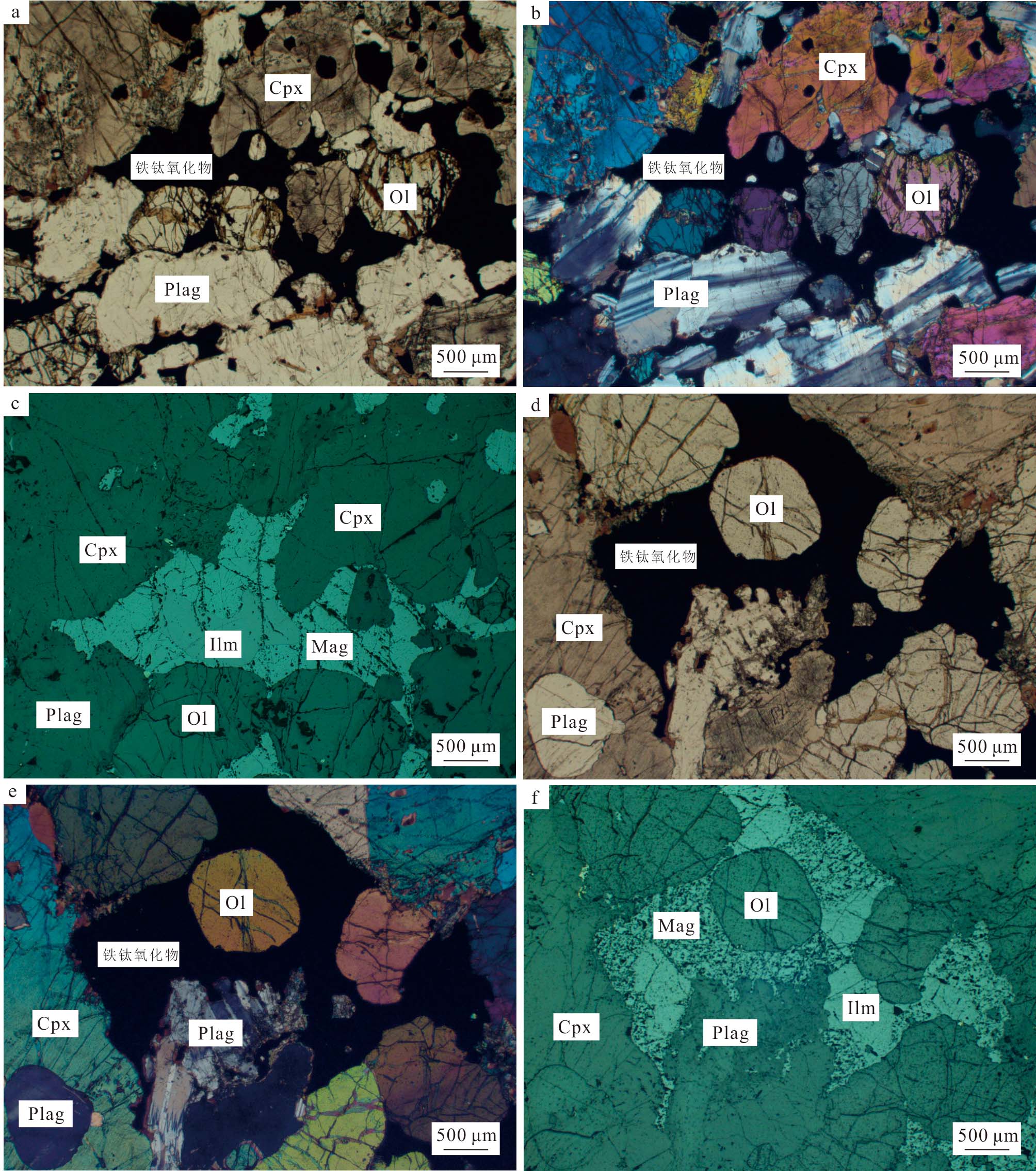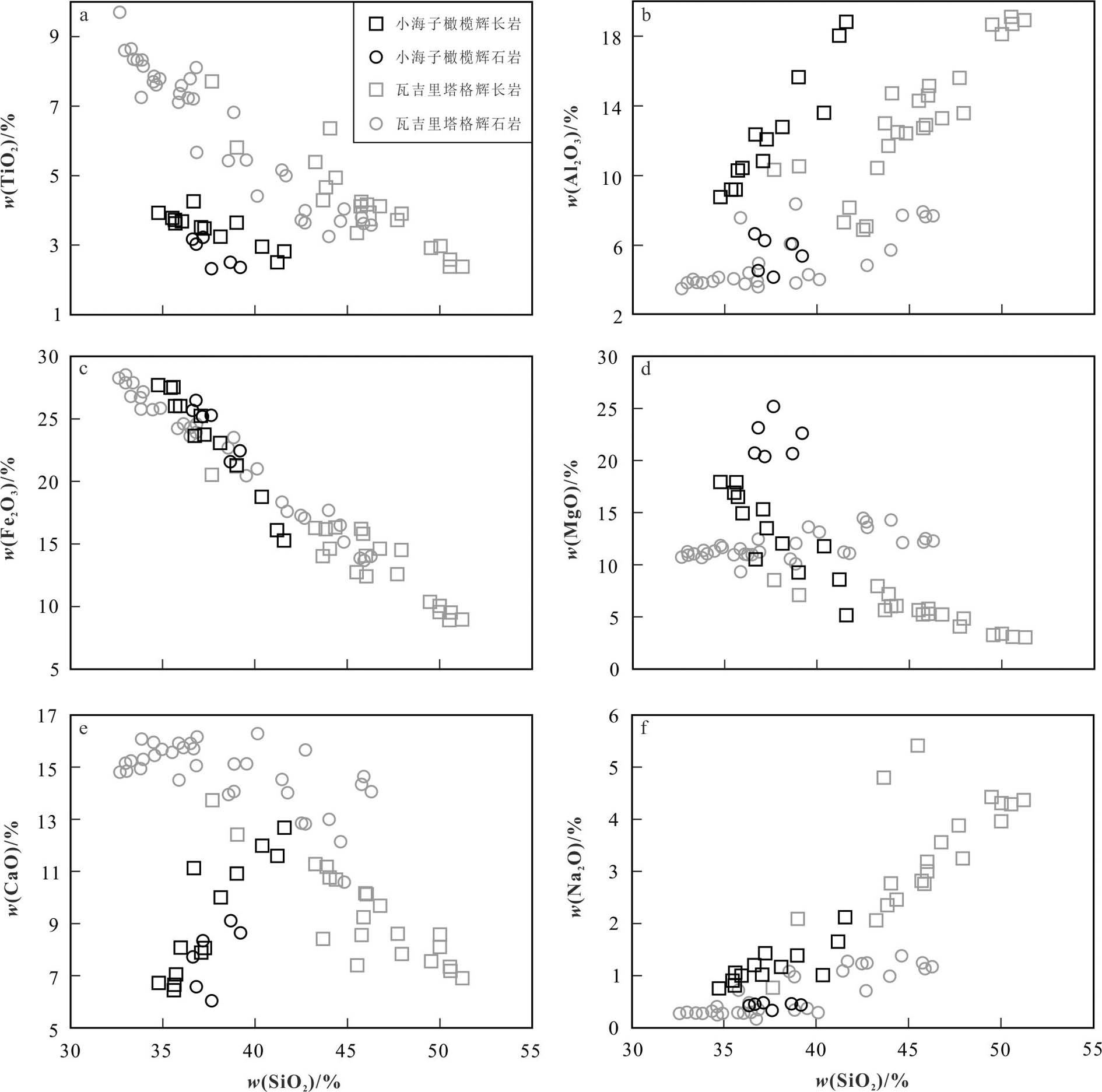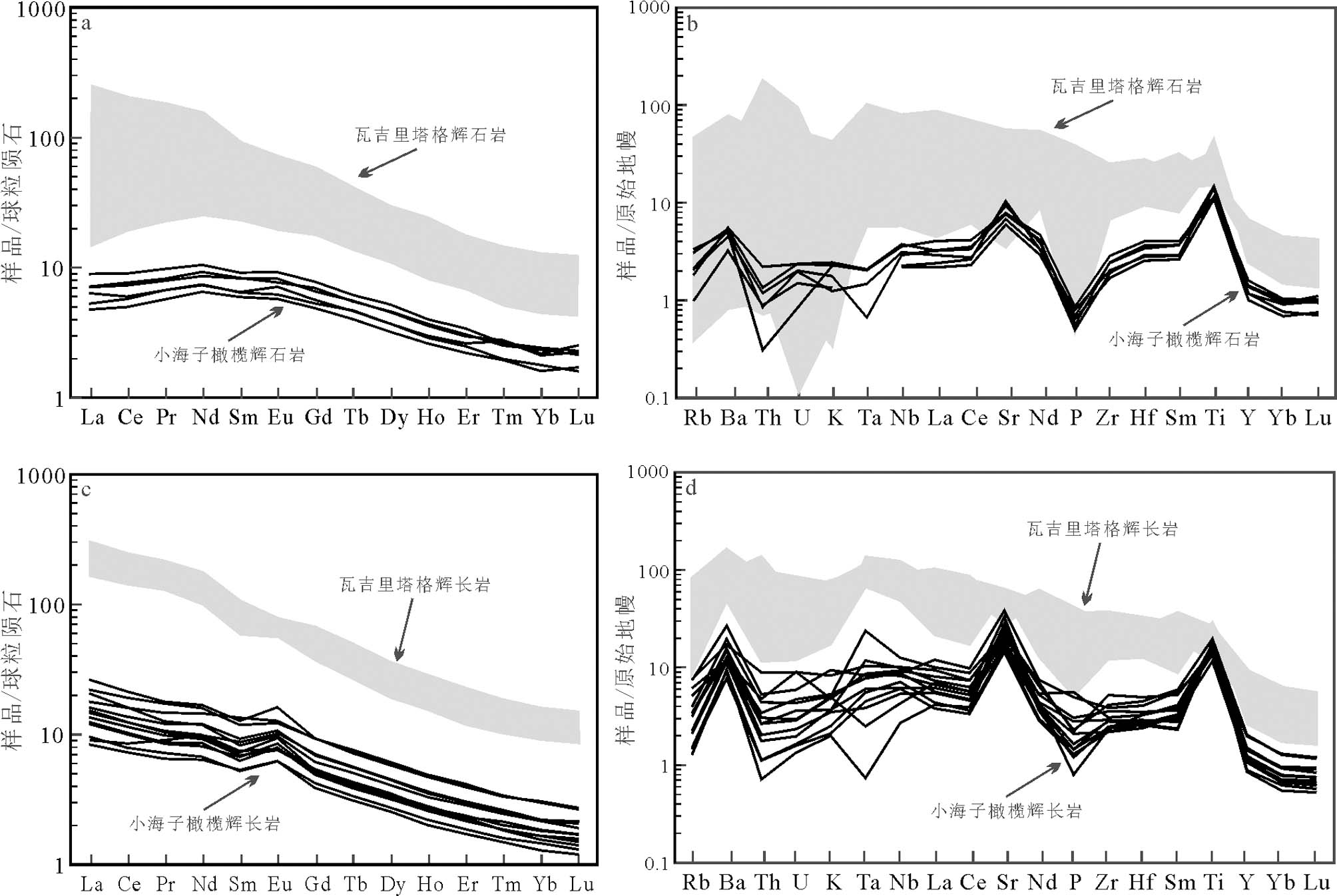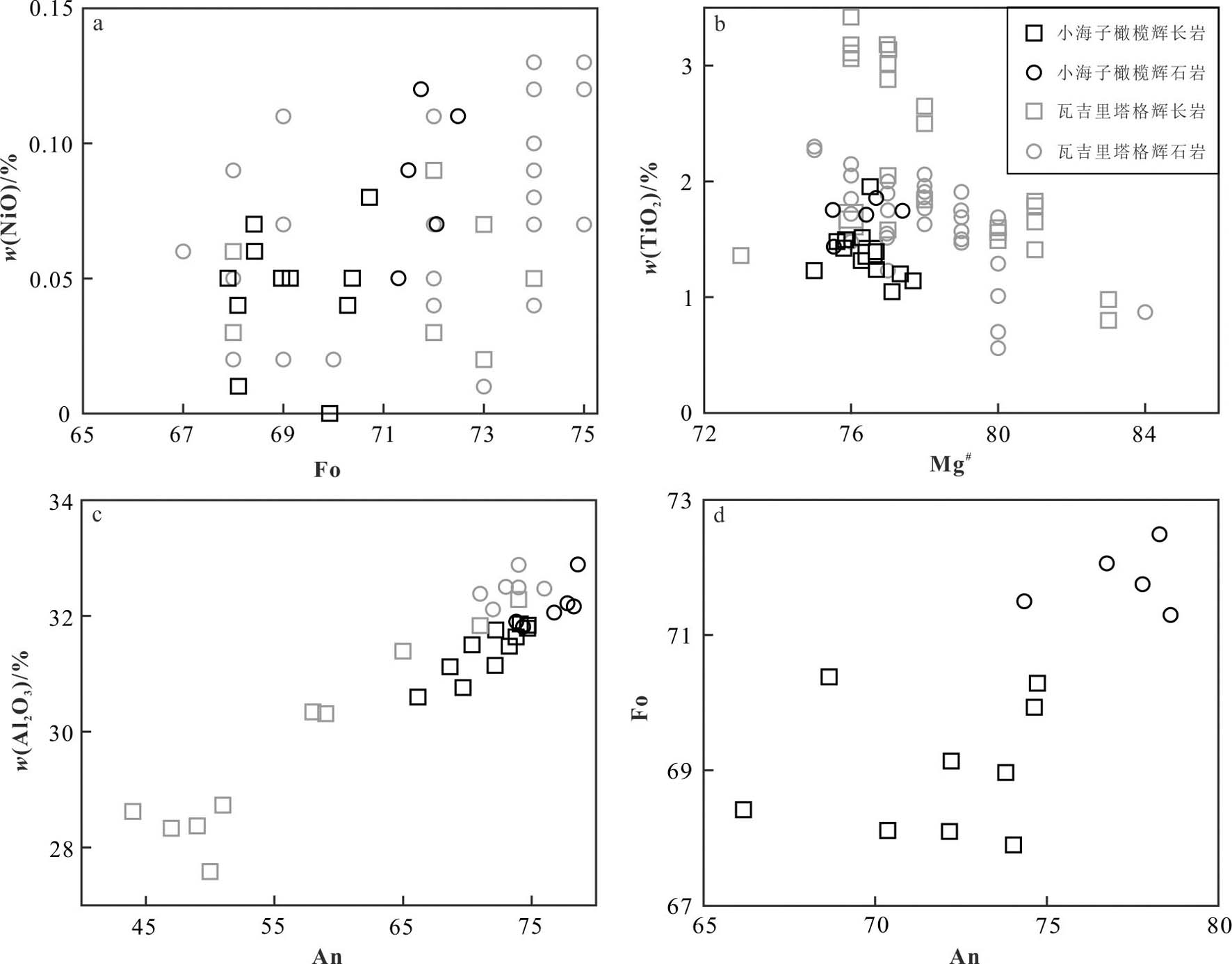-
大火成岩省的镁铁-超镁铁质侵入体中常赋存有丰富的钒钛磁铁矿资源,如南非Bushveld、加拿大Sept Iles和中国四川攀枝花地区(宋谢炎等, 2018;张招崇等, 2021;2022a)。中国西北的塔里木大火成岩省中也发育以瓦吉里塔格为代表的钒钛磁铁矿床,但矿石品位略逊于峨眉山大火成岩省的攀枝花地区(Zhang et al., 2014;杨合群,2020a)。近年来,针对瓦吉里塔格矿床北约50 km的小海子浅覆盖地区的勘查工作,取得了良好的找矿效果,探获近3亿吨的钒钛磁铁矿资源,含矿岩石为橄榄辉长岩和橄榄辉石岩,与瓦吉里塔格相似,但品位更低(倪康, 2012;梁孝伟等, 2023)。小海子含矿岩体研究程度较低,其中两种岩相橄榄辉长岩和橄榄辉石岩的相互关系尚不明确,也不清楚该岩体与瓦吉里塔格岩体是否具有成因联系以及其矿化强度更弱的原因所在。本研究以小海子岩体中橄榄辉长岩和橄榄辉石岩为研究对象,开展了地质地球化学研究,并与瓦吉里塔格岩体进行了对比分析,以期为上述问题的认识提供支撑。
1地质背景与岩体地质特征小海子岩体地处新疆南部巴楚地区,构造上位于塔里木克拉通西缘。塔里木克拉通位于中国西北部,北邻天山造山带,南接昆仑造山带和阿尔金造山带,覆盖面积超过60万km2(图1a)。塔里木克拉通西缘在早二叠世发育强烈的岩浆活动,大面积分布大陆溢流玄武岩、镁铁-超镁铁质侵入体、正长岩和花岗岩侵入体以及少量的粗面岩和流纹岩,构成了著名的塔里木大火成岩省(杨树峰等, 2005; Cheng et al., 2020;张招崇,2022b)。塔里木大火成岩省中产出3个赋存大规模钒钛磁铁矿资源的镁铁-超镁铁质侵入体,分别是小海子(麻扎尔塔格、恰瓦克南)岩体、瓦吉里塔格岩体和普昌(皮羌)岩体(图1a)。小海子岩体位于新疆巴楚县东南约25 km处的小海子水库东侧,瓦吉里塔格岩体位于小海子近正南方向约45 km,普昌岩体位于小海子岩体北东约100 km。
图1 新疆南部镁铁-超镁铁质岩体构造位置(a)和小海子岩体地质简图(b)(改自梁孝伟等,2023)
Fig.1 Tectonic location of the mafic-ultramafic intrusions in South Xinjiang (a) and simplified geologic map of the Xiaohaizi intrusion (b) (modified after Liang et al., 2023)
瓦吉里塔格岩体出露面积约12 km2,主要由辉石岩、辉长岩和橄榄辉石岩等组成,钒钛磁铁矿主要赋存于辉石岩中,矿石TFe品位一般在20.00%左右,w(TiO2)介于5.5%~8.5%之间,伴生w(V2O5)0.15%~0.20%(杨合群,2020a)。锆石U-Pb年代学研究表明,瓦吉里塔格岩体中辉石岩形成于284~281Ma,辉长岩形成于282~280Ma(Shangguan et al., 2016; Zhang et al., 2016; Zhu et al., 2021)。普昌岩体出露面积约25 km2,主要由辉石岩、辉长岩和斜长岩等组成,钒钛磁铁矿主要赋存于辉长岩中,矿床平均品位:TFe为26.70%,TiO2为4.17%,伴生V2O5为0.17%(杨合群,2020b)。普昌岩体中辉长岩锆石U-Pb定年结果为276~273 Ma(Zhang et al., 2010; Zhang et al., 2016)。
小海子岩体侵位于下石炭统巴楚组石英砂岩中,面积约13 km2,主要由橄榄辉长岩、橄榄辉石岩、钾长花岗岩、正长岩等组成(图1b)。钾长花岗岩和正长岩分布于岩体北部,出露较为完整。橄榄辉长岩和橄榄辉石岩大多被第四系沉积物覆盖,仅见零星露头。2010年,针对小海子岩体隐伏橄榄辉长岩和橄榄辉石岩的普查工作取得了良好的找矿效果,探获一个铁钛矿石量约3亿t的大型低品位钒钛磁铁矿矿床,其中橄榄辉长岩TFe品位18%~25%,橄榄辉石岩TFe品位16%~18%,两类岩石中w(TiO2)和w(V2O5)相似,分别为约3%~4%和0.1%(倪康, 2012;梁孝伟等, 2023)。年代学研究也表明各岩相形成时代大致相同,其中小海子岩体辉长岩形成时代为(283±3)Ma(张洪安等, 2009),橄榄辉石岩为279~278 Ma(Wei et al., 2014),钾长花岗岩和正长岩为286~277 Ma(杨树锋等, 1996;厉子龙等, 2008;孙燕等, 2009;张洪安等, 2009; Li et al., 2011;位旬等, 2011)。
小海子岩体中橄榄辉长岩主要由斜长石(30%~50%)、单斜辉石(15%~25%)、橄榄石(10%~20%)、铁钛氧化物(5%~10%)以及少量的角闪石和黑云母(<5%)组成(图2a~c),橄榄辉石岩主要由不同比例的单斜辉石(35%~45%)、橄榄石(25%~35%)、斜长石(5%~10%)、铁钛氧化物(5%~10%)以及少量的角闪石和黑云母(<5%)组成(图2d~f),部分样品中亦可见橄榄石含量超过单斜辉石的情况,可定名为辉石橄榄岩。斜长石、单斜辉石和橄榄石颗粒粗大,自形-半自形,通常粒径在0.5~5 mm之间,发育明显的堆晶结构。铁钛氧化物由紧密共生的钛磁铁矿和钛铁矿组成,分布于橄榄石、单斜辉石和斜长石矿物粒间,其中含钛磁铁矿中常见格架状或布纹状出溶的钛铁矿板条,钛铁矿大多表面干净,少量可见出溶赤铁矿板条。角闪石和黑云母较少发育,前者主要产于橄榄石或单斜辉石的边部,后者常与铁钛氧化物共生。
图2小海子岩体橄榄辉长岩(a~c)和橄榄辉石岩(d~f)镜下照片,铁钛氧化物分布于硅酸盐矿物粒间 Cpx—单斜辉石;Ilm—钛铁矿;Mag—磁铁矿;Plag—斜长石;Ol—橄榄石a、d. 单偏光;b、e.正交偏光;c、f.反射光
Fig. 2 Photomicrographs showing the petrographic characteristics of the olivine gabbro (a~c) and olivine pyroxenite (d~f) of the Xiaohaizi intrusion, with Fe-Ti oxides occurring interstitially in grain boundaries of silicate minerals Cpx—Clinopyroxene; Ilm—Ilmenite; Mag—Magnetite; Plag—Plagioclase; Ol—Olivinea, d. Plane polarized light; b, e. Crossed polarized light; c,f. Reflected light
2样品及测试方法本文选择小海子岩体19件样品开展矿物和全岩地球化学分析,全部为岩芯样品,其中13件橄榄辉长岩采自钻孔ZK1605(12件)钻孔ZK4605(1件),另外6件橄榄辉石岩样品采自钻孔ZK4605。钻孔ZK1605位于岩体西南,终孔414.7 m,除顶部约26 m的覆盖沙,其余部分岩性较为均一,为橄榄辉长岩和含橄辉长岩,局部可见被后期的闪长岩脉和辉绿岩脉穿切。钻孔ZK4605位于岩体西北,终孔428.2 m,除顶部约57 m的覆盖沙,其余部分主要为橄榄辉石岩,局部根据矿物组成的变化可定名为辉石橄榄岩和橄榄辉长岩。采样位置见图1b,样品照片见图2。
光薄片下橄榄石、单斜辉石和斜长石矿物主量元素分析应用JXA8230型电子探针完成。橄榄石和单斜辉石测试条件为电压15 kV、电流20 nA、束斑1 μm,斜长石测试条件为电压15 kV、电流10 nA、束斑3 μm。矿物电子探针分析采用SPI标准矿物作为标准样品,数据采用ZAF方法校正。
全岩粉末主量元素分析应用波长色散X射线荧光光谱仪(ZSXPrimusⅡ)完成,采用波长色散X射线荧光光谱法,测试依据中华人民共和国国家标准《硅酸盐岩石化学分析方法第28部分:16个主次成分量测定》(GB/T 14506.28- 2010)。全岩粉末微量元素分析应用电感耦合等离子体质谱仪(Agilent 7700e)完成,测试依据中华人民共和国国家标准《硅酸盐岩石化学分析方法第30部分:44个元素量测定》(GB/T14506.30-2010)。
3分析结果3.1矿物化学橄榄石、单斜辉石和斜长石主量元素分析结果见表1~3。
橄榄辉长岩中的橄榄石各组分变化范围较窄,其中w(SiO2)介于38.13%~38.42%之间,w(FeO)介于25.58%~28.80%之间,w(MgO)介于33.42%~35.17%之间,Fo值介于67.9~70.7之间(平均69.1)。相比而言,橄榄辉石岩中橄榄石各组分变化范围也较窄,但w(SiO2)和w(FeO)更低,而w(MgO)和Fo值更高,其中w(SiO2)介于37.34%~38.13%之间,w(FeO)介于24.27%~25.14%之间,w(MgO)介于35.56%~36.47%之间,Fo值介于71.3~72.5之间(平均71.8)。
橄榄辉长岩和橄榄辉石岩中的单斜辉石化学成分相似,均主要由SiO2、CaO、MgO、FeO以及少量的Al2O3、TiO2组成。橄榄辉长岩中的单斜辉石w(TiO2)介于1.05%~1.95%之间,Mg#介于75.0~77.7之间(平均76.4);橄榄辉石岩中的单斜辉石w(TiO2)介于1.44%~1.86%之间,Mg#介于75.5~77.4之间(平均76.3)。
橄榄辉长岩中的斜长石w(Al2O3)介于30.60%~32.43%之间(平均31.52%),An值介于66.2~74.7之间(平均71.8)。相比而言,橄榄辉石岩中的斜长石w(Al2O3)和An值略高,其中w(Al2O3)介于31.90%~32.89%之间(平均32.2%),An值介于73.8~78.6之间(平均76.6)。
3.2全岩主微量元素橄榄辉长岩和橄榄辉石岩全岩主微量元素分析结果见表4。
橄榄辉长岩和橄榄辉石岩具有相似的SiO2、TiO2、Fe2O3和CaO组分。橄榄辉长岩w(SiO2)介于34.77%~41.59%之间,w(TiO2)介于2.50%~4.26%之间,w(Fe2O3)介于15.27%~27.71%之间,w(CaO)介于6.45%~12.68%之间;橄榄辉石岩w(SiO2)介于36.63%~39.20%之间,w(TiO2)介于2.32%~3.22%之间,w(Fe2O3)介于21.57%~26.47%之间,w(Al2O3)介于6.03%~9.11%之间。与矿物组成相符,橄榄辉长岩比橄榄辉石岩w(Al2O3)(8.76%~18.82%和4.16%~6.65%)和w(Na2O)(0.76%~2.12%和0.33%~0.48%)更高,而w(MgO)(5.15%~17.92%和20.36%~25.16%)更低。总体来说,橄榄辉长岩主量元素变化范围比橄榄辉石岩更大,在哈克图解上显示出明显的相关性(图3a~f)。
橄榄辉长岩REE总量介于17.69×10-6~48.06×10-6之间,13件样品在稀土元素球粒陨石标准化配分图中均呈现相互平行的轻稀土元素富集型配分曲线(图4a~d),都具有较为明显的Eu正异常以及不明显的Ce异常,对应的LaN/YbN比值介于4.09~9.84之间,δEu比值介于1.14~1.51之间,δCe比值介于0.94~1.00之间(图4a)。橄榄辉石岩REE总量介于15.58×10-6~25.66×10-6之间,所有6件样品也都呈现相互平行的轻稀土元素富集型配分曲线,但轻稀土元素富集程度低于橄榄辉长岩,而且不发育明显的Eu和Ce异常,对应的LaN/YbN比值介于2.96~3.69之间,δEu比值介于1.01~1.18之间,δCe比值介于0.92~1.00之间(图4c)。在微量元素原始地幔标准化蛛网图上(图4b、d),橄榄辉长岩和橄榄辉石岩样品对应的曲线形态相似,均相对富集Ba、Sr和Ti元素,相对亏损P元素。
表1小海子橄榄辉长岩和橄榄辉石岩中橄榄石电子探针分析结果(w(B)/%)
Table 1 EPMA results (w(B)/%) of olivine from the olivine gabbro and olivine pyroxenite of the Xiaohaizi intrusion
点号
岩性
SiO2
FeO
MnO
MgO
CaO
NiO
总和
Fo
1605-3-2
橄榄辉长岩
37.67
26.97
0.37
34.09
0.08
0.05
99.23
68.97
1605-5-2
橄榄辉长岩
37.75
27.80
0.41
34.28
0.04
0.07
100.35
68.42
1605-8-2
橄榄辉长岩
37.93
26.34
0.43
34.93
0.03
0.00
99.66
69.93
1605-11-2
橄榄辉长岩
37.72
27.70
0.39
33.64
0.02
0.04
99.52
68.10
1605-19-2
橄榄辉长岩
37.87
27.80
0.36
33.42
0.04
0.05
99.55
67.90
1605-22-2
橄榄辉长岩
37.34
27.68
0.39
33.62
0.02
0.01
99.05
68.11
1605-24-2
橄榄辉长岩
37.85
25.81
0.39
34.93
0.03
0.05
99.06
70.38
1605-29-2
橄榄辉长岩
37.82
26.09
0.35
35.09
0.11
0.04
99.50
70.29
1605-31-2
橄榄辉长岩
37.72
27.46
0.38
33.85
0.06
0.06
99.52
68.43
1605-36-2
橄榄辉长岩
37.94
26.82
0.39
34.20
0.05
0.05
99.44
69.14
4605-6-2
橄榄辉长岩
38.13
25.58
0.38
35.17
0.06
0.08
99.40
70.72
4605-9-2
橄榄辉石岩
38.22
25.09
0.39
35.86
0.10
0.09
99.76
71.50
4605-11-2
橄榄辉石岩
38.30
24.27
0.40
36.47
0.07
0.11
99.62
72.49
4605-13-2
橄榄辉石岩
38.13
25.14
0.38
35.56
0.05
0.05
99.31
71.30
4605-17-2
橄榄辉石岩
38.42
24.55
0.37
36.05
0.08
0.07
99.53
72.06
4605-18-2
橄榄辉石岩
38.16
25.01
0.34
36.13
0.08
0.12
99.84
71.75
注:Fo=100×Mg/(Mg+Fe2+)。
表2小海子橄榄辉长岩和橄榄辉石岩中单斜辉石电子探针分析结果(w(B)/%)
Table 2 EPMA results (w(B)/%) of clinopyroxne from the olivine gabbro and olivine pyroxenite of the Xiaohaizi intrusion
点号
岩性
SiO2
TiO2
Al2O3
FeO
MnO
MgO
CaO
Na2O
总和
Mg#
1605-3-3
橄榄辉长岩
50.30
1.42
3.44
8.17
0.20
14.35
21.47
0.37
99.75
75.80
1605-5-3
橄榄辉长岩
52.23
1.05
2.23
7.92
0.26
14.97
21.54
0.32
100.56
77.11
1605-8-3
橄榄辉长岩
50.38
1.52
3.61
7.72
0.24
13.95
22.02
0.33
99.82
76.30
1605-11-3
橄榄辉长岩
50.96
1.39
3.43
7.62
0.24
14.05
22.27
0.38
100.35
76.68
1605-15-3
橄榄辉长岩
50.93
1.24
3.00
8.06
0.21
14.87
21.10
0.36
99.80
76.68
1605-19-3
橄榄辉长岩
50.66
1.47
3.69
8.02
0.18
13.95
21.16
0.43
99.60
75.61
1605-22-3
橄榄辉长岩
51.35
1.23
2.63
9.32
0.19
15.68
19.16
0.31
99.89
74.99
1605-24-3
橄榄辉长岩
51.44
1.14
2.74
7.41
0.21
14.48
21.51
0.35
99.29
77.68
1605-26-3
橄榄辉长岩
49.89
1.50
3.67
8.10
0.21
14.26
21.25
0.38
99.35
75.85
1605-29-3
橄榄辉长岩
50.89
1.32
3.05
8.17
0.18
14.74
21.35
0.31
100.04
76.28
1605-31-3
橄榄辉长岩
51.57
1.20
2.73
7.63
0.20
14.60
21.75
0.39
100.11
77.34
1605-36-3
橄榄辉长岩
50.48
1.39
3.63
7.69
0.13
14.05
22.36
0.40
100.17
76.51
4605-6-3
橄榄辉长岩
49.19
1.95
4.70
7.37
0.15
13.47
22.03
0.35
99.30
76.52
4605-4-3
橄榄辉石岩
50.12
1.75
4.27
8.01
0.20
13.85
21.52
0.41
100.21
75.50
4605-9-3
橄榄辉石岩
49.49
1.75
5.21
7.03
0.11
13.51
21.97
0.39
99.94
77.40
4605-11-3
橄榄辉石岩
50.57
1.44
3.34
8.11
0.17
14.04
21.58
0.44
99.77
75.53
4605-13-3
橄榄辉石岩
50.02
1.71
4.11
7.65
0.16
13.91
21.83
0.39
99.90
76.41
4605-17-3
橄榄辉石岩
49.61
1.86
4.39
7.55
0.14
13.93
21.89
0.40
99.85
76.68
注:Mg#=100×Mg/(Mg+Fe2+)。
4讨 论4.1岩浆演化序列根据钻孔揭露情况,小海子岩体中的橄榄辉长岩主要分布于岩体南侧,而橄榄辉石岩主要分布于岩体东侧,这两种岩相的空间关系尚不明确(倪康, 2012;梁孝伟等, 2023)。本次岩相学观察发现,岩体东侧的橄榄辉石岩主要由不同比例的堆晶橄榄石和单斜辉石构成,斜长石和铁钛氧化物呈填隙状分布于橄榄石和单斜辉石粒间,当局部斜长石富集时可以定名为橄榄辉长岩,与岩体南侧的橄榄辉长岩相学特征一致。在稀土元素球粒陨石标准化配分图(图4a、c)和微量元素原始地幔标准化蛛网图上(图4b、d),橄榄辉石岩和橄榄辉长岩样品的曲线形态相似,仅橄榄辉长岩中因斜长石含量更多而呈现Eu正异常(图4)。这些特征表明,小海子岩体中橄榄辉石岩和橄榄辉长岩是同源岩浆演化的产物,矿物组成的差异与堆晶作用有关。
表3小海子橄榄辉长岩和橄榄辉石岩中斜长石电子探针分析结果(w(B)/%)
Table 3 EPMA results (w(B)/%) of plagioclase from the olivine gabbro and olivine pyroxenite of the Xiaohaizi intrusion
点号
岩性
SiO2
TiO2
Al2O3
FeO
CaO
Na2O
K2O
总和
An
1605-3-1
橄榄辉长岩
48.65
0.13
31.63
0.69
14.80
2.76
0.22
98.88
73.80
1605-5-1
橄榄辉长岩
51.86
0.11
30.60
0.33
13.44
3.73
0.11
100.18
66.17
1605-8-1
橄榄辉长岩
49.30
0.09
31.81
0.41
14.90
2.75
0.07
99.34
74.64
1605-11-1
橄榄辉长岩
50.61
0.07
31.14
0.36
14.23
2.99
0.07
99.47
72.16
1605-15-1
橄榄辉长岩
49.51
0.04
31.47
0.34
14.73
2.92
0.08
99.11
73.27
1605-19-1
橄榄辉长岩
49.23
0.12
31.87
0.40
14.60
2.76
0.11
99.09
74.03
1605-22-1
橄榄辉长岩
50.03
0.10
31.50
0.32
14.55
3.34
0.07
99.92
70.37
1605-24-1
橄榄辉长岩
50.88
0.06
31.12
0.29
13.84
3.44
0.07
99.69
68.66
1605-26-1
橄榄辉长岩
50.21
0.03
30.76
0.32
14.18
3.32
0.14
98.96
69.67
1605-29-1
橄榄辉长岩
49.58
0.08
31.84
0.33
14.98
2.77
0.05
99.63
74.72
1605-36-1
橄榄辉长岩
49.51
0.04
31.75
0.35
14.76
3.04
0.14
99.59
72.22
4605-4-1
橄榄辉石岩
49.43
0.05
31.90
0.34
14.82
2.86
0.07
99.46
73.82
4605-9-1
橄榄辉石岩
49.52
0.09
31.81
0.31
15.09
2.84
0.06
99.72
74.34
4605-11-1
橄榄辉石岩
49.02
0.04
32.16
0.36
15.54
2.34
0.06
99.53
78.28
4605-13-1
橄榄辉石岩
48.22
0.05
32.89
0.35
15.78
2.33
0.07
99.68
78.60
4605-17-1
橄榄辉石岩
48.75
0.16
32.05
0.37
15.39
2.51
0.10
99.33
76.75
4605-18-1
橄榄辉石岩
48.61
0.10
32.22
0.33
16.12
2.50
0.07
99.93
77.79
注:An=100×Ca/(Ca+Na+K)。
橄榄辉石岩和橄榄辉长岩相比,橄榄石的Fo值更高(71.3~72.5 vs. 67.9~70.7),斜长石的An值也更高(73.8~78.6 vs. 66.2~74.7),所有样品投点在橄榄石NiO-Fo图解、斜长石Al2O3-An图解以及橄榄石Fo斜长石An图解中具有明显的正相关性(图5),这进一步说明橄榄石结晶早于斜长石,母岩浆分异过程中橄榄辉石岩相对橄榄辉长岩更早结晶。Cao等(2017)研究发现小海子岩体具有接近球粒陨石的γOs(t)值和很窄变化范围的εNd(t)值,认为母岩浆来自地幔,且没有受到明显的地壳混染。小海子岩体中最早结晶的橄榄石Fo值显著低于大火成岩省中具有原始岩浆特点的苦橄岩中橄榄石的Fo值(>85)(Zhang et al., 2006; Jin et al., 2019),说明形成于高度演化的岩浆,与幔源母岩浆在深部岩浆房中发生了分异有关。
4.2铁钛成矿意义小海子岩体和瓦吉里塔格岩体在空间上相距不超过50 km,二者形成时代一致。前人研究表明,小海子岩体中橄榄辉石岩的(87Sr/86Sr)i值和εNd(t)值分别为0.7042~0.7043和0.8~1.1(Wei et al., 2014),瓦吉里塔格岩体中辉石岩和辉长岩(87Sr/86Sr)i值和εNd(t)值分别为0.7038~0.7048和-0.4~3.0(Cao et al., 2017; Zhang et al., 2018; Zhu et al., 2021),两个岩体Sr-Nd同位素比值几乎完全一致。在稀土元素球粒陨石标准化配分图和微量元素原始地幔标准化蛛网图上,两个岩体中的辉石岩和辉长岩样品的配分曲线也具有相似的形态(图4a~d)。原始地幔标准化蛛网图上呈现的Sr正异常、P负异常和Ti正异常,与小海子岩体和瓦吉里塔格岩体中斜长石含量较高、磷灰石含量低和铁钛氧化物含量较高的特征相符。上述特征表明,小海子岩体和瓦吉里塔格岩体是同源岩浆演化的产物。
小海子岩体的w(TiO2)仅为3%~4%,而瓦吉里塔格岩体的w(TiO2)明显更高,介于5.5%~8.5%之间(杨合群,2020a;倪康, 2012)。矿物化学分析表明,硅酸盐矿物中Ti含量极低,说明全岩w(TiO2)的高低与铁钛氧化物的含量有关。在全岩地球化学组成上,除w(TiO2)不同外,小海子岩体还比瓦吉里塔格岩体具有更低的w(CaO)和更高的w(MgO),这与小海子岩体中橄榄石含量更高而辉石含量更低相符,说明小海子岩体比瓦吉里塔格岩体有更高比例的堆晶橄榄石和辉石。小海子岩体和瓦吉里塔格岩体样品在橄榄石NiO-Fo图解(图5a)和单斜辉石TiO2-Mg#图解(图5b)具有相互叠加的特点,但后者变化范围更大。同样,瓦吉里塔格斜长石An值的变化范围也明显大于小海子岩体(40~80 vs. 65~80)(图5c)。矿物组成较大的变化范围很可能指示岩体在形成过程中经历了更高程度的分离结晶作用,这可能是造成瓦吉里塔格岩体比小海子岩体w(TiO2)更高的原因
表4小海子岩体橄榄辉长岩和橄榄辉石岩主量元素(w(B)/%)和微量元素(w(B)/10-6)分析结果
Table 4 Major (w(B)/%) and trace (w(B)/10-6) element compositions of the olivine gabbro and olivine pyroxenite of the Xiaohaizi intrusion
对比项
橄榄辉长岩
橄榄辉石岩
1605-3
1605-5
1605-8
1605-11
1605-15
1605-19
1605-22
1605-24
1605-26
1605-29
1605-31
1605-36
4605-6
4605-4
4605-9
4605-11
4605-13
4605-17
4605-18
采样深度/m
44
53
65
79
96
121
133
161
212
264
304
378
237
216
258
263
287
333
368
SiO2
35.72
37.27
35.53
35.97
41.59
36.68
38.13
37.08
35.60
34.77
41.20
39.01
40.39
36.82
36.63
37.17
37.65
39.20
38.67
TiO2
3.62
3.48
3.78
3.66
2.82
4.26
3.24
3.52
3.75
3.93
2.50
3.64
2.96
3.03
3.17
3.22
2.32
2.36
2.51
Al2O3
10.29
12.07
9.21
10.44
18.82
12.35
12.78
10.83
9.19
8.76
18.02
15.64
13.59
4.54
6.65
6.26
4.16
5.37
6.08
TFe2O3
25.98
23.75
27.52
26.03
15.27
23.68
23.07
25.25
27.55
27.71
16.10
21.24
18.77
26.47
25.68
25.19
25.29
22.45
21.57
MnO
0.23
0.20
0.25
0.22
0.11
0.19
0.20
0.22
0.24
0.24
0.13
0.16
0.17
0.28
0.26
0.26
0.28
0.25
0.24
MgO
16.48
13.48
16.85
14.92
5.15
10.50
12.01
15.30
17.82
17.92
8.57
9.23
11.76
23.13
20.69
20.36
25.16
22.61
20.65
CaO
7.05
8.06
6.67
8.08
12.68
11.13
10.00
7.89
6.45
6.72
11.60
10.92
11.98
6.58
7.72
8.34
6.03
8.64
9.11
Na2O
1.03
1.43
0.90
1.00
2.12
1.20
1.17
1.02
0.82
0.76
1.65
1.39
1.01
0.35
0.45
0.48
0.33
0.44
0.46
K2O
0.14
0.25
0.16
0.11
0.28
0.15
0.15
0.11
0.08
0.06
0.15
0.10
0.06
0.04
0.07
0.07
0.04
0.05
0.07
P2O5
0.06
0.07
0.03
0.12
0.11
0.05
0.05
0.04
0.03
0.03
0.05
0.03
0.02
0.02
0.01
0.01
0.01
0.01
0.02
LOI
-0.89
-0.10
-0.52
-0.47
0.88
-0.37
-0.56
-0.82
-1.27
-1.05
-0.13
-0.44
-0.35
-1.09
-1.08
-0.92
-1.07
-0.82
1.59
总和
99.71
99.95
100.35
100.08
99.83
99.81
100.25
100.43
100.25
99.85
99.84
100.91
100.36
100.16
100.27
100.45
100.21
100.57
100.96
Li
4.09
4.26
4.08
3.67
4.50
2.32
3.20
2.61
2.75
3.05
2.45
2.37
1.69
2.85
2.60
2.53
2.28
1.91
2.11
Be
0.33
0.45
0.26
0.26
0.55
0.32
0.41
0.23
0.18
0.18
0.28
0.22
0.39
0.78
0.10
0.24
0.14
0.16
0.18
Sc
20.57
23.51
22.02
24.23
28.96
38.08
29.45
23.18
19.44
22.08
22.02
25.94
34.70
29.60
29.83
34.75
26.33
35.83
38.55
V
672
652
733
691
494
778
682
679
745
754
475
696
506
509
537
553
386
395
402
Co
167
147
166
155
72
120
121
150
173
174
89
114
107
175
158
157
173
145
138
Ni
350
281
299
321
133
205
231
304
349
354
205
107
465
488
716
571
611
642
626
Cu
253
235
117
217
129
110
144
132
127
159
173
139
541
221
121
371
218
238
230
Zn
169
149
196
175
101
144
160
156
192
173
98
126
114
171
171
178
162
138
136
Ga
17.46
18.82
17.66
17.83
22.23
20.80
20.13
17.30
15.26
15.79
20.67
19.82
18.43
11.69
12.34
13.07
8.84
10.59
11.69
As
0.41
0.49
0.37
0.47
0.62
0.56
0.61
0.43
0.35
0.20
0.39
0.34
0.43
0.69
0.42
0.50
0.43
0.35
0.55
Rb
3.87
4.75
3.22
2.13
4.67
2.16
2.48
1.32
0.95
0.92
1.98
1.42
0.81
1.34
2.10
1.93
0.61
1.29
1.14
Sr
402
457
349
369
800
446
468
406
332
304
693
585
501
142
218
195
124
159
164
Y
5.62
6.39
4.87
6.81
9.11
9.21
8.91
5.25
3.84
4.01
4.82
4.93
6.57
5.24
5.29
6.14
4.50
6.36
7.15
续表4
Continued Table 4
对比项
橄榄辉长岩
橄榄辉石岩
1605-3
1605-5
1605-8
1605-11
1605-15
1605-19
1605-22
1605-24
1605-26
1605-29
1605-31
1605-36
4605-6
4605-4
4605-9
4605-11
4605-13
4605-17
4605-18
采样深度/m
44
53
65
79
96
121
133
161
212
264
304
378
237
216
258
263
287
333
368
Zr
32.36
39.45
31.92
34.17
42.73
45.93
57.76
31.08
26.77
24.31
24.23
27.40
25.87
22.52
21.14
26.88
18.70
27.31
31.76
Nb
5.82
7.14
6.20
7.03
6.19
6.57
8.91
4.38
5.03
4.30
3.03
3.81
1.91
2.20
1.59
2.65
1.55
2.04
2.51
Mo
0.42
0.69
0.48
0.44
0.67
0.47
1.14
0.59
0.76
0.30
0.34
0.31
0.27
1.77
0.28
0.27
0.44
0.38
0.25
Cs
0.15
0.14
0.13
0.10
0.32
0.06
0.05
0.03
0.01
0.01
0.03
0.02
0.02
0.05
0.08
0.07
0.02
0.05
0.07
Ba
82.82
118.29
80.78
87.53
185.03
102.33
136.12
78.55
63.91
53.47
108.57
87.30
66.17
36.05
34.38
37.55
22.35
31.24
38.69
La
4.53
6.40
3.85
4.98
8.16
5.52
6.84
4.20
2.98
2.59
4.73
3.72
2.82
1.98
1.64
2.19
1.48
2.21
2.77
Ce
10.02
13.04
8.33
11.07
17.29
12.97
15.49
9.25
6.39
5.89
10.08
8.09
6.92
4.84
4.64
5.91
4.03
6.20
7.29
Pr
1.30
1.54
1.06
1.47
2.18
1.79
2.10
1.20
0.88
0.79
1.27
1.03
1.11
0.82
0.82
0.96
0.69
1.00
1.19
Nd
5.95
7.08
5.15
7.20
10.09
8.73
9.55
5.54
4.03
3.84
5.65
4.86
5.93
4.45
4.39
5.15
3.90
5.57
6.30
Sm
1.45
1.61
1.22
1.81
2.48
2.61
2.30
1.34
1.02
1.04
1.42
1.30
1.72
1.26
1.27
1.61
1.16
1.62
1.79
Eu
0.57
0.71
0.58
0.78
1.19
0.93
0.90
0.56
0.46
0.46
0.69
0.62
0.75
0.46
0.52
0.60
0.42
0.56
0.68
Gd
1.40
1.59
1.27
1.79
2.42
2.40
2.41
1.38
1.00
1.10
1.36
1.33
1.83
1.37
1.46
1.70
1.27
1.81
2.02
Tb
0.20
0.24
0.18
0.26
0.35
0.36
0.34
0.20
0.15
0.16
0.20
0.19
0.27
0.22
0.22
0.26
0.19
0.26
0.29
Dy
1.11
1.31
1.02
1.44
1.90
1.97
1.86
1.14
0.82
0.88
1.08
1.07
1.46
1.19
1.19
1.46
1.03
1.48
1.68
Ho
0.20
0.24
0.19
0.25
0.34
0.35
0.34
0.20
0.14
0.16
0.19
0.19
0.26
0.21
0.21
0.26
0.19
0.26
0.29
Er
0.49
0.60
0.45
0.63
0.86
0.87
0.83
0.50
0.36
0.39
0.48
0.47
0.64
0.55
0.52
0.62
0.46
0.64
0.72
Tm
0.07
0.08
0.06
0.08
0.11
0.11
0.11
0.06
0.05
0.05
0.06
0.06
0.09
0.09
0.06
0.09
0.06
0.08
0.09
Yb
0.39
0.45
0.35
0.45
0.62
0.63
0.64
0.38
0.27
0.30
0.32
0.35
0.46
0.44
0.37
0.46
0.34
0.49
0.51
Lu
0.06
0.06
0.05
0.07
0.09
0.09
0.09
0.05
0.04
0.04
0.05
0.05
0.07
0.07
0.05
0.08
0.06
0.07
0.07
Hf
0.82
1.08
0.89
1.00
1.25
1.38
1.52
0.79
0.79
0.81
0.74
0.87
1.00
0.86
0.88
1.04
0.78
1.12
1.23
Ta
0.35
0.42
0.31
0.48
0.34
0.35
0.97
0.25
0.23
0.18
0.10
0.16
0.03
0.06
n.d.
0.08
n.d.
0.03
0.08
Pb
1.48
1.66
1.98
2.53
2.53
0.96
1.61
1.24
1.16
1.14
1.70
0.72
2.31
3.57
3.60
2.54
1.02
1.88
2.13
Th
0.40
0.75
0.29
0.22
0.45
0.22
0.37
0.15
0.10
0.09
0.26
0.17
0.06
0.07
0.03
0.11
0.07
0.10
0.19
U
0.19
0.19
0.10
0.08
0.12
0.06
0.09
0.04
0.03
0.03
0.06
0.05
0.03
0.04
0.02
0.05
0.03
0.04
0.05
图3小海子岩体橄榄辉长岩和橄榄辉石岩哈克图解(瓦吉里塔格岩体值据Li et al., 2012;Cao et al., 2014;Zhang et al., 2018)
Fig. 3 Harker diagrams of the olivine gabbro and olivine pyroxenite of the Xiaohaizi intrusion (rock compositions of Wajilitage are from Li et al., 2012; Cao et al., 2014; Zhang et al., 2018)
4.3铁钛资源利用前景岩浆型钒钛磁铁矿床是中国重要的铁、钛资源,矿石中有用矿物为钛磁铁矿和钛铁矿,主要分布于四川攀枝花-西昌地区和河北承德大庙地区,分别与镁铁质层状岩体和斜长岩杂岩体有关。除此之外,冀北-辽西地区分布有大量与辉石岩-角闪石岩体有关的低品位钒钛磁铁矿资源,目前也已开发利用(李厚民等, 2009;2012;2023; 李立兴等, 2012)。根据现货价格,铁精矿约为870元/t,而钛精矿(w(TiO2)≥46%)约为2260元/t,因此钒钛磁铁矿中铁和钛的共同利用具有重要的经济价值。
图4小海子岩体橄榄辉长岩和橄榄辉石岩稀土元素球粒陨石标准化配分图(a、c)和微量元素原始地幔标准化蛛网图(b、d)(球粒陨石标准化值据Boynton, 1984;原始地幔标准化值据Sun et al., 1989;瓦吉里塔格岩体值据Li et al., 2012;Cao et al., 2014;Zhang et al., 2018)
Fig.4 Chondrite-normalized REE patterns (a, c) and primitive mantle-normalized trace element spider diagrams (b, d) of the olivine gabbro and olivine pyroxenite of the Xiaohaizi intrusion (chondrite values are from Boynton, 1984;primitive mantle values are from Sun et al., 1989; rock compositions of Wajilitage are from Li et al., 2012; Cao et al., 2014; Zhang et al., 2018)
然而,四川攀枝花-西昌地区、河北承德大庙地区和冀北-辽西地区的钒钛磁铁矿石常发育固溶体分离结构,表现为钛磁铁矿内部发育布纹状或格架状钛铁矿片晶,钛铁矿中发育赤铁矿片晶,这使得钒钛磁铁矿石磨矿过程中难以实现磁铁矿和钛铁矿的单体解离,影响了选矿效率(陈汪兴等, 2020;于宏东等, 2020)。与上述地区相比,新疆小海子岩体和瓦吉里塔格岩体中的钛磁铁矿和钛铁矿不太发育固溶体分离结构,矿物表面干净,更利于铁和钛的选矿分离(图2c、f)。河北承德大庙地区钒钛磁铁矿的TiO2平均品位为4.53%(于宏东等,2020),小海子岩体和瓦吉里塔格岩体TiO2含量与之相当或略高,钛资源利用前景巨大。
经济价值是影响矿床资源评价的重要因素。针对冀北地区的低品位-大吨位钒钛磁铁矿资源,河北省2010年出台了地方标准“超贫磁铁矿勘查技术规范(DB13/T 1349-2010)”,大大提高了资源保障程度。新疆南部地区与塔里木大火成岩省有关的低品位-大吨位钒钛磁铁矿资源出露地表或浅覆盖,易于开发,可利用性更高,单体经济价值更大,建议出台针对性的勘查技术规范。
5结 论(1) 小海子岩体中橄榄辉石岩和橄榄辉长岩是同源岩浆演化的产物,橄榄石较低的Fo值指示幔源母岩浆在深部岩浆房中发生了分异。
图5小海子岩体橄榄辉长岩和橄榄辉石岩中橄榄石、单斜辉石和斜长石矿物组分图解(瓦吉里塔格岩体值据Zhang et al., 2018)Cpx—单斜辉石;Plag—斜长石;Ol—橄榄石
Fig. 5 Binary diagrams for olivine, clinopyroxene and plagioclase compositions from the olivine gabbro and olivine pyroxenite of the Xiaohaizi intrusion (mineral compositions of Wajilitage are from Zhang et al., 2018)Cpx—Clinopyroxene; Ilm—Ilmenite; Mag—Magnetite; Plag—Plagioclase; Ol—Olivine
(2) 岩体在形成过程中经历了更高程度的分离结晶作用以及更低比例的堆晶橄榄石和辉石是造成瓦吉里塔格岩体比小海子岩体w(TiO2)更高的原因。
(3) 小海子岩体和瓦吉里塔格岩体中铁和钛选矿解离容易,钛资源利用前景巨大。
致 谢 野外工作和样品采集得到相关地勘单位的帮助,在此表示感谢。
-
参考文献
Cao J, Wang C Y, Xu Y G , Xing C M and Ren M H. 2017. Triggers on sulfide saturation in Fe-Ti oxide-bearing, mafic-ultramafic layered intrusions in the Tarim Large Igneous Province, NW China[J]. Mi-neralium Deposita, 52: 471-494.
Cao J, Wang C Y, Xing C M and Xu Y G. 2014. Origin of the Early Permian Wajilitag igneous complex and associated Fe-Ti oxide mineralization in the Tarim Large Igneous Province, NW China[J]. Journal of Asian Earth Sciences, 84: 51-68.
Chen W X, Liang H J, Gao Z X and Xue X X. 2020. Study on process mineralogy of a vanadium titanium magnetite concentrate in Chaoyang district, Liaoning Province[J]. Journal of China South University (Science and Technology), 51(10): 2681-2688(in Chinese with English abstract).
Cheng Z G, Zhang Z C, Wang Z C, Wang F Y, Mao Q, Xu L J, Ke S and Yu H M. 2020. Petrogenesis of transitional large ignous Province: Insights from bimodal volcanic suite in the Tarim Large Igneous Province[J]. Journal of Geophysical Research: Solid Earth, 125(5): 1-22.
Jin S K, Zhang Z C, Cheng Z G, Xie Q H, Fei X H, Santosh M and Wang F Y. 2019. Compositions of olivine from the Wajilitag mafic-ultramafic intrusion of the Permian Tarim Large Igneous pro-vince, NW China: Insights into recycled pyroxenite in a peridotite mantle source[J]. Journal of Asian Earth Sciences, 171: 9-19.
Li H M, Wang R J, Xiao K Y, Zhang X H, Liu Y L and Sun L. 2009. Characteristics and current utilization status of ultra-low-grade magnetite resource, and suggestion on its exploration and development[J]. Geological Bulletin of China, 28(1): 85-90.
Li H M, Wang D H, Li LX, Chen J, Yang X Q and Liu M J. 2012. Metallogenic regularity of iron deposits and resource potential of major iron minerogeenetic units in China[J]. Geology in China, 39(3):559-580(in Chinese with English abstract).
Li H M, Wang R J, Xiao K Y, Zhang X H, Liu Y L and Sun L. 2009. Characteristics and current utilization status of ultra-low-grade magnetite resource, and suggestion on its exploration and development[J]. Geological Bulletin of China, 28(1):85-90(in Chinese with English abstract).
Li H M, Ji X Z, Bi M F, Li LX, Li X S and Ni S Q. 2023. Relationship between total iron grade and magnetite iron grade of Chinese magnetite iron ores and its significance[J]. Mineral Deposits, 42(4): 729-740(in Chinese with English abstract).
Li L X, Li H M, Wang D Z, Liu M J, Yang X Q and Chen J. 2012. Ore genesis and ore forming age of Timahabaqin ultra-low grade iron deposit in Chengde, Hebei Province, China[J]. Rock and Mineral Analysis, 31(5): 898-905(in Chinese with English abstract).
Li Y Q, L Z L, Chen H L, Yang S F and Yu X. 2012. Mineral characte-ristics and metallogenesis of the Wajilitag layered mafic-ultramafic intrusion and associated Fe-Ti-V oxide deposit in the Tarim Large Igneous Province, northwest China[J]. Journal of Asian Earth Sciences, 49: 161-174.
Li Z L, Chen H L, Song B, Li Y Q, Yang S F and Yu X. 2011. Temporal evolution of the Permian Large Igneous Province in Tarim Basin in northwestern China[J]. Journal of Asian Earth Sciences, 42: 917-927.
Li Z L, Yang S F, Chen H L, Langmiur C H, Yu X, Lin X B and Li Y Q. 2008. Chronology and geochemistry of Taxinan basalts from the Tarim Basin: Evidence for Permian plume magmatism[J]. Acta Petrologica Sinica, 24(5): 959-970(in Chinese with English abstract).
Liang X W and Yang F F. 2023. Metallogenic and geological condition of Qiawak South V-Ti magnetite ore deposit in Xinjiang, the ore-control factors and ore prediction[J]. Contributions to Geology and Mineral Resources Research, 38(1): 73-80(in Chinese with English abstract).
Ni K. 2012. Discovery of the Mazaertagh V-Ti magnetite deposit in western Tarim and its significance tiltle in English[J]. Advances in Earth Science, 2012 (S1): 236-239.
Shangguan S M, Peate I U, Tian W and Xu Y G. 2016. Re-evaluating the geochronology of the Permian Tarim magmatic Province: Implications for temporal evolution of magmatism[J]. Journal of the Geological Society, 173(1): 228-239.
Song X Y, Chen L M, Yu S Y, Tao Y, She Y W, Luan Y and He H L. 2018. Geological features and genesis of V-Ti magnetite deposits in Emeishan Large Igneous Province, SW China[J]. Bulletin of Mineralogy, Petrology and Geochemistry, 37(6): 1003-1018(in Chinese with English abstract).
Sun S S and McDonough W F. 1989. Chemical and isotopic systematics of oceanic basalts: Implications for mantle composition and processes[A]. In: Sauders A D and Norry M J, eds., Magmatism in the Ocean Basins[C]. Journal of the Geological Society, London. pp. 313-345.
Sun Y, Xiao Y P, Zhao X K, Qian Y Q, Xiao G W and Liu H Q. 2009. The zircon U-Pb age of Mazar’er and Tage alkalic complex in the Tarim Basin its geologic significance[J]. Acta Geologica Sinica, 83: 775-781(in Chinese with English abstract).
Wei X and Xu Y G. 2011. Petrogenesis of Xiaohaizi syenite complex from Bachu area, Tarim[J]. Acta Petrologica Sinica, 27: 2984-3004(in Chinese with English abstract).
Wei X, Xu YG, Zhang C L, Zhao J X and Feng Y X. 2014. Petrology and Sr-Nd isotopic disequilibrium of the Xiaohaizi intrusion, NW China: Genesis of layered intrusions in the Tarim Large Igneous Province[J]. Journal of Petrology, 55(12): 2567-2598.
Yang H Q. 2020a. Magmatic type V-Ti magnetite in Xinjiang Wajlitage[J]. Northwesten Geology, 53(4): 129(in Chinese with English abstract).
Yang H Q. 2020b. Magmatic type V-Ti magnetite in Xinjiang Puchang[J]. Northwestern Geology, 53(1): 137(in Chinese with English abstract).
Yang S F, Chen H L, Dong C W, Jia C Z and Wang Z G. 1996. The discovery of Permian syenite inside Tarim basin and its geodynamic significance[J]. Geochemica, 25: 121-128(in Chinese with English abstract).
Yang S F, Chen H L, Ji D W, Li Z L, Dong C W, Jia C Z and Wei G Q. 2005. Geological process of Early to Middle Permian magmatism in Tarim Basin and its geodynamic significance[J]. Geological Journal of China Universities, 11(4): 504-511(in Chinese with English abstract).
Yu H D, Wang L N, Qu J K and Qi T. 2020. Process mineralogical characteristics and ore value of typical vanadium titanium magnetite in China[J]. Journal of Northeastern University (Natural Science), 41(2): 275-281(in Chinese with English abstract).
Zhang D Y, Zhang Z C, Huang H, Encarnación J, Zhou N W and Ding X X. 2014. Platinum-group elemental and Re-Os isotopic geochemistry of the Wajilitag and Puchang Fe-Ti-V oxide deposits, northwestern Tarim Large Igneous Province[J]. Ore Geology Reviews, 57: 589-601.
Zhang C L, Xu Y G, Li Z X, Wang H Y and Ye H M. 2010. Diverse Permian magmatism in the Tarim Block, NW China: Genetically linked to the Permian Tarim mantle plume[J]? Lithos, 119(3-4): 537-552.
Zhang D, Zhang Z , Huang H, Cheng Z and Charlier B. 2018. Petrogenesis and metallogenesis of the Wajilitag and Puchang Fe-Ti oxide-rich intrusive complexes, northwestern Tarim Large Igneous Province[J]. Lithos, 304: 412-435.
Zhang D Y, Zhang Z C, Mao J W, Huang H and Cheng Z G. 2016. Zircon U-Pb ages and Hf-O isotopic signatures of the Wajilitag and Puchang Fe-Ti oxide-bearing intrusive complexes: Constraints on their source characteristics and temporal-spatial evolution of the Tarim Large Igneous Province[J]. Gondwana Research, 37: 71-85.
Zhang H A, Li Y J, Wu G Y, Su W, Qian Y X, Meng, Q L, Cai X Y, Han L J, Zhao Y and Liu Y L. 2009. Isotopic geochronology of Permian igneous rocks in the Tarim Basin[J]. Chinese Journal of Geology, 44: 137-158(in Chinese with English abstract).
Zhang Z C, Mahoney J J, Mao J W and Wang F S. 2006. Geochemistry of picritic and associated basalt flows of the western Emeishan flood basalt province, China[J]. Journal of Petrology, 47(10): 1997-2019.
Zhang Z C, Li H M, Li J W, Song X Y, Hu H, Li L X, Chai F M, Hou T and Xu D R. 2021. Geological setting and metallogenesis of high-grade iron deposits in China[J]. Science China Earth Sciences, 51(6): 827-852(in Chinese with English abstract).
Zhang Z C, Hou T and Cheng Z G. 2022a. Mineralization related to Large Igneous Provinces[J]. Acta Geologica Sinica, 96(1): 131-154(in Chinese with English abstract).
Zhang Z C, Zhu Jiang, Cheng Z G, Wei B W, Hou T, Zhang H L and Xie Q H. 2022b. Classification, genesis of Large Igneous Pro-vince associated with its effect on earth system [J]. Acta Geologica Sinica, 96(12): 4057-4090(in Chinese with English abstract).
Zhu S Z, Huang X L, Yang F and He P L. 2021. Petrology and geochemistry of Early Permian mafic-ultramafic rocks in the Wajilitag area of the southwestern Tarim Large Igneous Province: Insights into Fe-rich magma of mantle plume activity[J]. Lithos, 398: 106355.
附中文参考文献
陈汪兴,梁海军,高子先,薛向欣. 2020.辽宁朝阳地区某钒钛磁铁矿中铁精矿的工艺矿物学研究[J].中南大学学报(自然科学版), 51(10): 2681-2688.
李厚民,王瑞江,肖克炎,张晓华,刘亚玲,孙莉. 2009.中国超贫磁铁矿资源的特征、利用现状及勘查开发建议——以河北和辽宁的超贫磁铁矿资源为例[J].地质通报, 28(1): 85-90.
李厚民,王登红,李立兴,陈靖,杨秀清,刘明军. 2012.中国铁矿成矿规律及重点矿集区资源潜力分析[J].中国地质, 39(3):559-580.
李厚民,戢兴忠,毕珉烽,李立兴,李小赛,倪善芹. 2023.中国磁性铁矿石全铁品位和磁性铁品位关系及其意义[J].矿床地质, 42(4): 729-740.
李立兴,李厚民,王德忠,刘明军,杨秀清,陈靖. 2012.河北承德铁马哈叭沁超贫铁矿床的成因与成矿时代[J].岩矿测试, 31(5): 898-905.
厉子龙,杨树锋,陈汉林,余星,林秀彬,励音骐. 2008.塔西南玄武岩年代学和地球化学特征及其对二叠纪地幔柱岩浆演化的制约[J].岩石学报, 24(5): 959-970.
梁孝伟,杨凡凡. 2023.新疆恰瓦克南钛磁铁矿成矿地质条件,控矿因素及找矿预测[J].地质找矿论丛, 38(1): 73-80.
倪康. 2012.新疆塔里木西段麻扎尔塔格V-Ti磁铁矿的发现及其意义[J].地球科学进展, 2012 (S1): 236-239.
宋谢炎,陈列锰,于宋月,陶琰,佘宇伟,栾燕,何海龙. 2018.峨眉大火成岩省钒钛磁铁矿矿床地质特征及成因[J].矿物岩石地球化学通报, 37(6): 1003-1018.
孙燕,肖渊甫,赵锡奎,钱一雄,肖光武,刘虹强. 2009.塔里木盆地麻扎尔塔格碱性杂岩体LA-ICP-MS锆石U-Pb年龄及地质意义[J].地质学报, 83(6): 775-781.
位荀,徐义刚. 2011.塔里木巴楚小海子正长岩杂岩体的岩石成因探讨[J].岩石学报, 27(10): 2984-3004.
杨合群. 2020a.新疆瓦吉里塔格岩浆型钒钛磁铁矿[J].西北地质, 53(4): 129.
杨合群. 2020b.新疆普昌岩浆型钒钛磁铁矿[J].西北地质, 53(1): 137.
杨树锋,陈汉林,董传万,贾承造,汪振国. 1996.塔里木盆地二叠纪正长岩的发现及其地球动力学意义[J].地球化学, 25(2): 121-128.
杨树锋,陈汉林,冀登武,厉子龙,董传万,贾承造,魏国齐. 2005.塔里木盆地早-中二叠世岩浆作用过程及地球动力学意义[J].高校地质学报, 11(4): 504-511.
于宏东,王丽娜,曲景奎,齐涛. 2020.中国典型钒钛磁铁矿的工艺矿物学特征与矿石价值[J].东北大学学报(自然科学版), 41(2): :275-281.
张洪安,李曰俊,吴根耀,苏文,钱一雄,孟庆龙,蔡习尧,韩利军,刘亚雷. 2009.塔里木盆地二叠纪火成岩的同位素年代学[J].地质科学, 44(1): 137-158.
张招崇,李厚民,李建威,宋谢炎,胡浩,李立兴,柴凤梅,侯通,许德如. 2021.我国铁矿成矿背景与富铁矿成矿机制[J].中国科学:地球科学, 51(6): 827-852.
张招崇,侯通,程志国. 2022a.大火成岩省的成矿效应[J].地质学报, 96(1): 131-154.
张招崇,朱江,程志国,魏博雯,侯通,张宏罗,谢秋红. 2022b.大火成岩省的类型、成因及其地球系统意义[J].地质学报, 96(12): 4057-4090.
摘要
新疆巴楚小海子是近年来在塔里木大火成岩省探获的一个低品位-大吨位岩浆型钒钛磁铁矿床,其成岩成矿机制以及资源利用前景尚不清楚。文章针对小海子岩体2种含矿岩相橄榄辉长岩和橄榄辉石岩开展了地质地球化学研究。橄榄辉长岩相和橄榄辉石岩相虽然在空间上关系不明,但岩相学观察表明它们矿物组成的差异与矿物堆晶作用有关,且二者具有相似的稀土元素球粒陨石标准化和微量元素原始地幔标准化配分曲线,说明是同源岩浆演化的产物,橄榄石较低的Fo值(67.9~72.5)指示幔源母岩浆在深部岩浆房中发生了分异。小海子岩体和与相距约45 km的瓦吉里塔格相比,岩石组成和地球化学组成相似,表明为同源岩浆成因,但后者矿物组成变化范围更大,指示瓦吉里塔格岩体在形成过程中经历了更高程度的分离结晶作用,这可能是造成瓦吉里塔格岩体比小海子岩体的w(TiO2)更高的原因。小海子岩体虽然w(TiO2)较低(3%~4%),但铁钛氧化物固溶体分离结构不发育,且矿物颗粒粗大,使得铁和钛选矿解离比中国其他地区的钒钛磁铁矿更为容易,因此钛资源利用前景巨大,笔者建议出台地方性的勘查技术规范,为这类铁钛资源的开发利用提供技术标准。
Abstract
The Xiaohaizi is a low-grade but large-tonnage magmatic Fe-Ti deposit that newly discovered in the Tarim Large Igneous Province. The sequence of magma evolution, the genetic relationship with other deposits in the same area, as well as the resource utilization prospect of the Xiaohaizi deposit remain unclear. This study carried out geological and geochemical studies of two types of ore bearing rock facies of olivine gabbro and olivine pyroxenite. Although the facies of olivine gabbro and olivine pyroxenite are not spatially in contact, petrographic observations indicate that the differences in their mineral assemblages are related to mineral accumulation. These two facies show similar chondrite-normalized REE patterns and primitive mantle-normalized patterns, suggesting a comagmatic feature. The low Fo values (67.9~72.5) of olivine indicate significant differentiation of mantle-derived magma in the deep magma chamber. The Xiaohaizi and Wajilitage intrusion show similar petrographic and geochemical characteristics, indicating that they are comagmatic. However, the latter has a larger range of mineral composition, which implies that the Wajilitage intrusion experienced a higher degree of fractional crystallization during magma evolution, and this may be the reason why the Wajilitage intrusion having higherw(TiO2) contents than the Xiaohaizi intrusion. Although thew(TiO2) contents (3%~4%) of the Xiaohaizi intrusion is relatively low, the features of nondevelopment of solid solution separation structure and coarse grain size are in favor of iron and titanium separation in the beneficiation process. Thus, it is recommended to establish a regional exploration technical specification for the low-grade but large-tonnage Fe-Ti resources in South Xinjiang.
